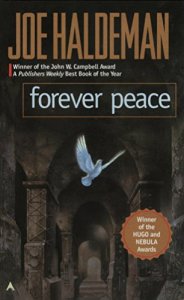I really enjoyed this more than I thought. Very commendable plot that kept moving – new factions and crises continually added all the way to the end.
<SPOILER WARNING>
The action begins in the near future aboard a comet-mining ship called Rockhopper. While they are on a routine mission, Saturn’s moon Janus breaks orbit and starts accelerating in the direction of the star Spica. Apparently it was never a moon at all, but some kind of alien spacecraft! Based on its acceleration, the only chance humanity has of studying it up close before it leaves the solar system is Rockhopper.
As Rockhopper (after some crises and political struggles) approaches Janus, it begins noticing something odd – it is accelerating too! Apparently there is some kind of field around Janus that has caught them in its net. Despite all they can do, escape or rescue is impossible and Rockhopper’s only hope is to land on Janus and try to survive. That’s just what they do, for the 13 year (to them) / 260 year (for Earth – relativity is funny that way) voyage to Spica.
The Rockhopper crew call their Janus hosts the Spicans, even though they are never contacted and never see any of them – apparently Janus is a completely automated ship. Some kind of megastructure awaits them at Spica, but a few months before approaching a kind of roof, called the “iron sky”, is constructed over the surface of Janus by the Spican automated machinery. Not long after they figure they have arrived at the megastructure, a hole is cut in the iron sky and some aliens, the massive, jellyfish-mountain like creatures dubbed the Fountainheads come in to say hello. They are many thousands of years more advanced than the humans, but fortunately they are friendly and share some technology, such as the ability to rejuvenate aging humans and even bring some of them back from death. But they don’t tell the humans much at all about where they are or why – though they do reveal that they aren’t the Spicans, and that other spacefaring races are also present in the megastructure.
Skipping to the punchline, it turns out that Rockhopper is inside what amounts to a vast, abandoned cosmic zoo. And they aren’t at Spica, but inside some other megastructure many millions of light years away. The Spican structure was only an accelerator of sorts to get them as fast as they needed to go. What they figure out is that the Spicans (they continue calling them that for lack of a better term) created many Janus-like ships in order to bring many different alien civilizations together in one place. You see, intelligent life is rare and fleeting in the universe; it appears at random times and different places in the universe. Not many spacefaring civilizations (maybe none) are ever in existence at the same time and place. To get around this, the Spican ships exploit the properties of relativity to bring everyone together at the end of the universe – all of them have traveled different distances and at different speeds, but have arrived at the structure within the same few decades or centuries or millenia at least. Forward-only time travel, I suppose!
Why did the Spicans do this? Who knows. Maybe to fulfill some Star Trek fantasy? The Spicans themselves are confirmed as gone, either of their own accord or perhaps destroyed by some of the zoo’s inmates at some time in the past. What’s left is a bunch of alien species, not all friendly, vying and scheming for survival and (sometimes) escape.
Mixed in with all this world-building based plot is a friendship-turned-rivalry between Rockhopper captain Bella Lind and chief engineer Svetlana Barseghian (one complaint with this audiobook – I really hated the Dracula-like accent he did for Svetlana…); some continuation of Earth politics as China sends its own ship to investigate (interesting how all the Earth scheming just fades away completely from the story as the Rockhopper realizes they are on their own on Janus); and a bizarre far-future Earth, so inspired by the Rockhopper’s self-sacrificial journey even 18000 years in the future that they send them some aid at the end of the universe in the form of a black cube full of morphable femtotech (this was kind of cool but did feel tacked on).
Finally, I’m not sure if it was just a reused plot device or an intentional theme, but there were many instances of some superior concealing knowledge “for your own good”. First, Earth fudges Rockhopper’s fuel tank readings to make the crew believe they have enough gas to get back home – in reality, it seems it always impossible to do anything other than a one-way trip. Then during the journey, when they are still receiving data from Earth, Bella hides traumatic earth events so as to not worry crew with family still there. Then later she doesn’t tell her subordinates about some concerning threats she learns about from the Fountainheads, such as about the Musk Dogs who end up destroying Janus. The Fountainheads themselves are hesitant to say much about the truth about the “zoo” they are all in (letting humans think they are still at the megastructure near Spica). Finally, the future humans also hesitate to share their full power, at first.
And one more theme/revelation from this story – no matter how advanced technology becomes, we’ll never escape politics. There will always be factions pushing for one course or another; learning how to get along while disagreeing is going to be an eternal requirement. (No matter how some may long for the day when heathens are burned away and all that remains are their tribal compatriots!)









